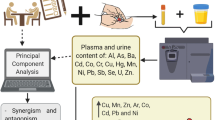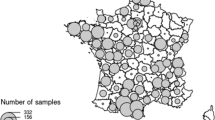Abstract
Dithiocarbamates (DTC) are the most commonly used synthetic fungicides in the Prosecco District (PD) of Treviso. The DTC biomarker is urinary ethylenethiourea (u-ETU). The aims of this biomonitoring study are to describe the level of u-ETU in residents in PD and to identify the factors associated with DTC exposure. In 2012 (baseline), we randomly extracted data for 126 children (3–5 years) and their families (260 adults), who were resident in 8 municipalities of PD and not occupationally exposed to DTC, from the local health database. For each subject, we obtained urine samples and socio-demographic, lifestyle and dietary information. In 2014 (after intervention), we evaluated the possible changes in u-ETU in 54 adults and 55 children at high risk of DTC exposure. The median baseline u-ETU was 0.35 µg/L. Approximately 5% of the samples had a u-ETU concentration > 5 µg/L. No u-ETU concentration exceeded 21 µg/L. Determinants of a higher u-ETU concentration were wine consumption (OR 2.04) and personal use of pesticides (OR 2.70) for adults; and living within 30 m from a vineyard (OR 9.51) and the pesticides use in the family (OR 6.25) for children. A significant u-ETU reduction in 49 adults and 25 children was observed from baseline to after intervention (p = 0.01). Wine consumption and production and DTC use in gardening influenced u-ETU concentrations in this population, although the levels were relatively low. The reduction in u-ETU from baseline to time after intervention probably reflects the effects of public health interventions.

Similar content being viewed by others
References
Aprea C, Catenacci G (2003) Società italiana valori di riferimento, Atti 4° Congresso Nazionale “1a Lista S.I.V.R. dei valori di riferimento”. Dec 14–16 2000; Castello di San Gaudenzio (PV)
Aprea C, Betta A, Catenacci G, Lotti A, Minoia C, Passini W, Pavan I, Robustelli Della Cuna FS, Roggi C, Ruggero R, Soave C, Sciarra G, Vannini P, Vitalone V (1996) Reference values of urinary ethylenethiourea in four regions of Italy (multicentric study). Sci Total Environ 192:83–93
ARPAV (Agenzia Regionale per la Prevenzione e Protezione Ambientale del Veneto) (2012) Vendite fitosanitari anno 2012. ARPAV. http://www.arpa.veneto.it/dati-ambientali/open-data/fitosanitari. Accessed 27 April 2018
ARPAV (Agenzia Regionale per la Prevenzione e Protezione Ambientale del Veneto) (2014) Vendite fitosanitari anno 2014. ARPAV. http://www.arpa.veneto.it/dati-ambientali/open-data/fitosanitari. Accessed 27 April 2018
Bevan R, Jones K, Cocker J, Assem FL, Levy LS (2013) Reference ranges for key biomarkers of chemical exposure within the UK population. Int J Hyg Environ Health 216(2):170–174
Bjørling-Poulsen M, Andersen HR, Grandjean P (2008) Potential developmental neurotoxicity of pesticides used in Europe. Environ Health 7(1):50
Castorina R, Bradman A, Fenster L, Boyd Barr D, Bravo R, Vedar MG, Harnly ME, Mckone TE, Eisen EA, Eskenazi B (2010) Comparison of current-use pesticide and other toxicant urinary metabolite levels among pregnant women in the CHAMACOS cohort and NHANES. Environ Health Perspect 118(6):856–863
Cocker J, Mason HJ, Warren ND, Cotton RJ (2011) Creatinine adjustment of biological monitoring results. Occup Med 61(5):349–353
Colosio C, Fustinoni S, Birindelli S, Campo L, Fustinoni S, Harari H, Somaruga C, Tiramani M, Visentin S, Maroni M (2002) Ethylenethiourea in urine as an indicator of exposure to mancozeb in vineyard workers. Toxicol Lett 134:133–140
Colosio C, Harari R, Birindelli S, Campo L, Fustinoni S, Harari H, Somaruga C, Tiramani M, Visentin S, Maroni M (2003) Occupational exposure to fungicides in floricolture in Ecuador. G Ital Med Lav Ergon 25(suppl 3):107–108
Colosio C, Visentin S, Birindelli S, Campo L, Fustinoni S, Mariani F, Tiramani M, Tommasini M, Brambilla G, Maroni M (2006) Reference values for ethylenethiourea in urine in Northern Italy: results of a pilot study. Toxicol Lett 162(2-3 spec. iss.):153–157
Comune di Conegliano (2014) Regolamento intercomunale di polizia rurale. Comune di Conegliano. http://www.comune.conegliano.tv.it/download/regolamenti/13274Reg77.pdf. Accessed 27 Apr 2018
Comune di Follina (2014) Regolamento Polizia Rurale_Modifica_2014_delibera di c.c. n. 2 2014. Comune di Follina. http://www.comune.follina.tv.it/home/Servizi/Regolamenti.html. Accessed 27 Apr 2018
Consiglio Comunale San Pietro di Feletto (2011) Regolamento intercomunale di polizia rurale : stralcio sulla gestione e sull’ uso dei prodotti fitosanitari nei comuni della DOCG Conegliano-Valdobbiadene. Comune di San Pietro di Feletto. http://www.comune.sanpietrodifeletto.tv.it/files/RegolamentodiPoliziaRurale_1_.pdf. Accessed 27 Apr 2018
Consorzio di tutela del vino Conegliano Valdobbiadene Prosecco (2016) Protocollo viticolo del Conegliano Valdobbiadene Prosecco Superiore DOCG. Consorzio di tutela del vino Conegliano Valdobbiadene Prosecco. http://www.prosecco.it/wp-content/uploads/2016/03/DPL_PROTOCOLLO_base_2016.pdf Accessed 27 Apr 2018
EPA (Environmental Protection Agency) (2005) Reregistration eligibility decision for Mancozeb. United States Environmental Protection Agency. EPA738-R-98-010
Fustinoni S, Campo L, Colosio C, Birindelli S, Foà V (2005) Application of gas chromatography-mass spectrometry for the determination of urinary ethylenethiourea in humans. J Chromatogr, B: Anal Technol Biomed Life Sci 814:251–258
Goldner WS, Sandler DP, Yu F, Hoppin JA, Kamel F, Levan TD (2010) Pesticide use and thyroid disease among women in the agricultural health study. Am J Epidemiol 171(4):455–464
Handal AJ, Hund L, Páez M, Bear S, Greenberg C, Fenske RA, Barr DB (2016) Characterization of pesticide exposure in a sample of pregnant women in Ecuador. Environ Contam Toxicol 70(4):627–639
Houeto P, Bindoula G, Hoffman JR (1995) Ethylenebisdithiocarbamates and ethylenethiourea: possible human health hazards. Environ Health Perspect 103(6):568–573
IARC (International Agency for Research on Cancer) (2001) Monographs on the evaluation of carcinogenic risks to humans. IARC Monogr 79:727
IARC (International Agency for Research on Cancer) (2017) Agents classified by the IARC monographs, vol 1–104. IARC Monogr 1–25
IPCS (International Programme on Chemical Safety) (1988) Dithiocarbamate pesticides, ethylenethiourea and propylenethiourea:a general introduction. IPCS Inchem home. http://www.inchem.org/documents/ehc/ehc/ehc78.htm. Accessed 27 Apr 2018
ISTAT (Istituto Nazionale di Statistica) (2000) 5° censimento agricoltura 2000. https://www4.istat.it/it/censimento-agricoltura/agricoltura-2000. Accessed 27 Apr 2018
Kurttio P, Savolainen K (1990) Ethylenethiourea in air and in urine as an indicator of exposure to ethylenebisdithiocarbamate fungicides. Scand J Work Environ Heal 16(3):203–207
Lerro CC, Beane Freeman LE, DellaValle CT, Kibriya MG, Aschebrook-Kilfoy B, Farzana J, Koutros S, Parks CG, Sandler DP, Alavanja MCR, Hofmann JN, Ward MH (2017) Occupational pesticide exposure and subclinical hypothyroidism among male pesticide applicators. Occup Environ Med 1:1. https://doi.org/10.1136/oemed-2017-104431
Marinovich M, Guizzetti M, Ghilardi F, Viviani B, Corsini E, Galli CL (1997) Thyroid peroxidase as toxicity target for dithiocarbamates. Arch Toxicol 71(8):508–512
Medda E, Santini F, De Angelis S, Franzellin F, Fiumalbi C, Perico A, Gilardi E, Mechi MT, Marsili A, Citroni A, Leandri A, Mantovani A, Vitti P, Olivieri A (2017) Iodine nutritional status and thyroid effects of exposure to ethylenebisdithiocarbamates. Environ Res 154:152–159
National Toxicology Program (2011) Ethylene thiourea. Rep Carcinog 12:191–194
Panganiban LR, Cortes-Maramba N, Dioquino C, Suplido ML, Ho H, Francisco-Rivera A, Manglicmot-Yabes A (2004) Correlation between blood ethylenethiourea and thyroid gland disorders among banana plantation workers in the Philippines. Environ Health Perspect 112(1):42–45
Rath NC, Rasaputra KS, Liyanage R, Huff GR Huff WE (2011) Dithiocarbamate toxicity—an appraisal. http://www.intechopen.com/books/pesticides-in-the-modern-world-effects-of-pesticides-exposure/dithiocarbamate-toxicity-an-appraisal. Accessed 27 Apr 2018
Roberts JR, Karr CJ (2012) Pesticide exposure in children. Pediatrics 130(6):e1765–e1788
Runkle JD, Tovar-Aguilar JA, Economos E, Flocks J, Williams B, Muniz JF, Semple M, McCauley L (2013) Pesticide risk perception and biomarkers of exposure in florida female farmworkers. J Occup Environ Med 55:1286–1292
Runkle J, Flocks J, Economos J, Dunlop AL (2017) A systematic review of Mancozeb as a reproductive and developmental hazard. Environ Int 99:29–42
SIVR (Società Italiana Valori di Riferimento) (2017) 4° Lista dei valori di riferimento per elementi, composti organici e loro metaboliti, edizione 2017. SIVR
Steenland K, Cedillo L, Tucker J, Hines C, Sorense K, Deddens J, Cruz V (1997) Thyroid hormones and cytogenetic outcomes in backpack sprayers using ethylenebisdithiocarbamate (EBDC) fungicides in Mexico. Environ Health Perspect 105(10):1126–1130
Sugeng AJ, Beamer PI, Lutz EA, Rosales CB (2013) Hazard-ranking of agricultural pesticides for chronic health effects in Yuma County, Arizona. Sci Total Environ 463–464:35–41
ULSS (Unità Locale Socio-Sanitaria) 7- Pieve di Soligo (2013) Livelli e fattori predittivi di esposizione ai ditiocarbammati negli abitanti delle zone viticole dell’Azienda ULSS 7. ULSS7. https://www.ulss7.it/documents/10181/90936/Livelli+e+fattori+predittivi+di+esposizione+ai+ditiocarbammati+negli+abitanti+delle+zone+viticole+dell%27Azienda+Ulss+7.pdf/c63fae91-48b0-4af9-83c4-c95490b33a67. Accessed 27 Apr 2018
ULSS 7- Pieve di Soligo (2016) Livelli e fattori predittivi di esposizione ai ditiocarbammati negli abitanti delle zone viticole dell’Azienda ULSS 7- Seconda fase. ULSS7. https://www.ulss7.it/documents/10181/90936/report+studio+pilota+di+biomonitoraggio+seconda+fase_dicembre+2016.pdf/0a11f4ab-0913-426d-a0f2-15a885ab6037. Accessed 27 Apr 2018
Unione Europea (2009) REGOLAMENTO (CE) N. 790/2009 della Commissione Europea. Gazzetta ufficiale dell’Unione Europea. http://www.iss.it/binary/cnsc/cont/Regol_790_2009.pdf. Accessed 27 Apr 2018
U.S. EPA (United States Environmental Protection Agency) (2001) The grouping of a series of dithiocarbamate pesticides based on a common mechanism of toxicity. Arch. EPA. https://archive.epa.gov/scipoly/sap/meetings/web/pdf/dithiofinal_aug17.pdf. Accessed 27 Apr 2018
U.S. EPA (United States Environmental Protection Agency) (2005) Mancozeb Facts. US EPA Arch. https://archive.epa.gov/pesticides/reregistration/web/pdf/mancozeb_fact.pdf Accessed 27 Apr 2018
U.S. EPA (United States Environmental Protection Agency) (2016) Chemicals evaluated for carcinogenic potential. NPIC (National Pesticide Information Center). http://npic.orst.edu/chemicals_evaluated.pdf. Accessed 27 Apr 2018
van Wendel de Joode B, Mora AM, Cordoba L, Cano JC, Quesada R, Faniband M, Wesswling C, Ruepert C, Oberg, Eskenazi B, Megler D, Lindh CH (2014) Aerial application of Mancozeb and urinary ethylene thiourea (ETU) concentrations among Pregnant Women in Costa Rica: The Infants’ Environmental Health Study (ISA). Environ Health Perspect 122(12):1321–1328
van Wendel de Joode B, Mora AM, Lindh CH, Lindh CH, Hernández-Bonilla D, Córdoba L, Wesseling C, Hoppin A, Mergler D (2016) Pesticide exposure and neurodevelopment in children aged 6–9 years from Talamanca, Costa Rica. Cortex 85:137–150
WHO (World Health Organization) (1988) Dithiocarbamate pesticides, ethylenethiourea, and propylenethiourea : a general introduction. The United Nations Environment Programme, the International Labour Organisation, and the World Health Organization. https://apps.who.int/iris/handle/10665/39117 Accessed 27 Apr 2018
WHO (World Health Organization) (2008) Pesticides: children’s health and the environment. World Health Organization. http://www.who.int/ceh/capacity/Pesticides.pdf. Accessed 27 Apr 2018
Xu S (2000) Environmental fate of ethylenethiourea. Environ. Monit. Pest Manag. Dep. Pestic. Regul. http://cdpr.ca.gov/docs/emon/pubs/fatememo/etu.pdf. Accessed 27 Apr 2018
Acknowledgements
The authors would like to thank the personnel of the Public Health Department of Treviso and the municipality technicians who played an important role in data collection and the families who participated in this study.
Funding
This study was supported by the Province of Treviso and the Mountain Community of Prealpi Trevigiane. The funding sources had no involvement in the collection, analysis and interpretation of the data, the writing of the manuscript or the decision to submit the article for publication.
Author information
Authors and Affiliations
Corresponding author
Ethics declarations
Conflict of interest
The authors declare that they have no conflicts of interest.
Ethical Approval
All procedures performed in the studies involving human participants were in accordance with the ethical standards of the institutional research committee and with the 1964 Helsinki Declaration and its later amendments or comparable ethical standards.
Informed Consent
Informed consent was obtained from all individual participants included in the study.
Additional information
Publisher's Note
Springer Nature remains neutral with regard to jurisdictional claims in published maps and institutional affiliations.
Rights and permissions
About this article
Cite this article
Sammartano, F., Castriotta, L., Chermaz, E. et al. Levels of Ethylenethiourea (u-ETU) in a Population Living Near Vineyards. Expo Health 12, 227–241 (2020). https://doi.org/10.1007/s12403-019-00307-x
Received:
Revised:
Accepted:
Published:
Issue Date:
DOI: https://doi.org/10.1007/s12403-019-00307-x




